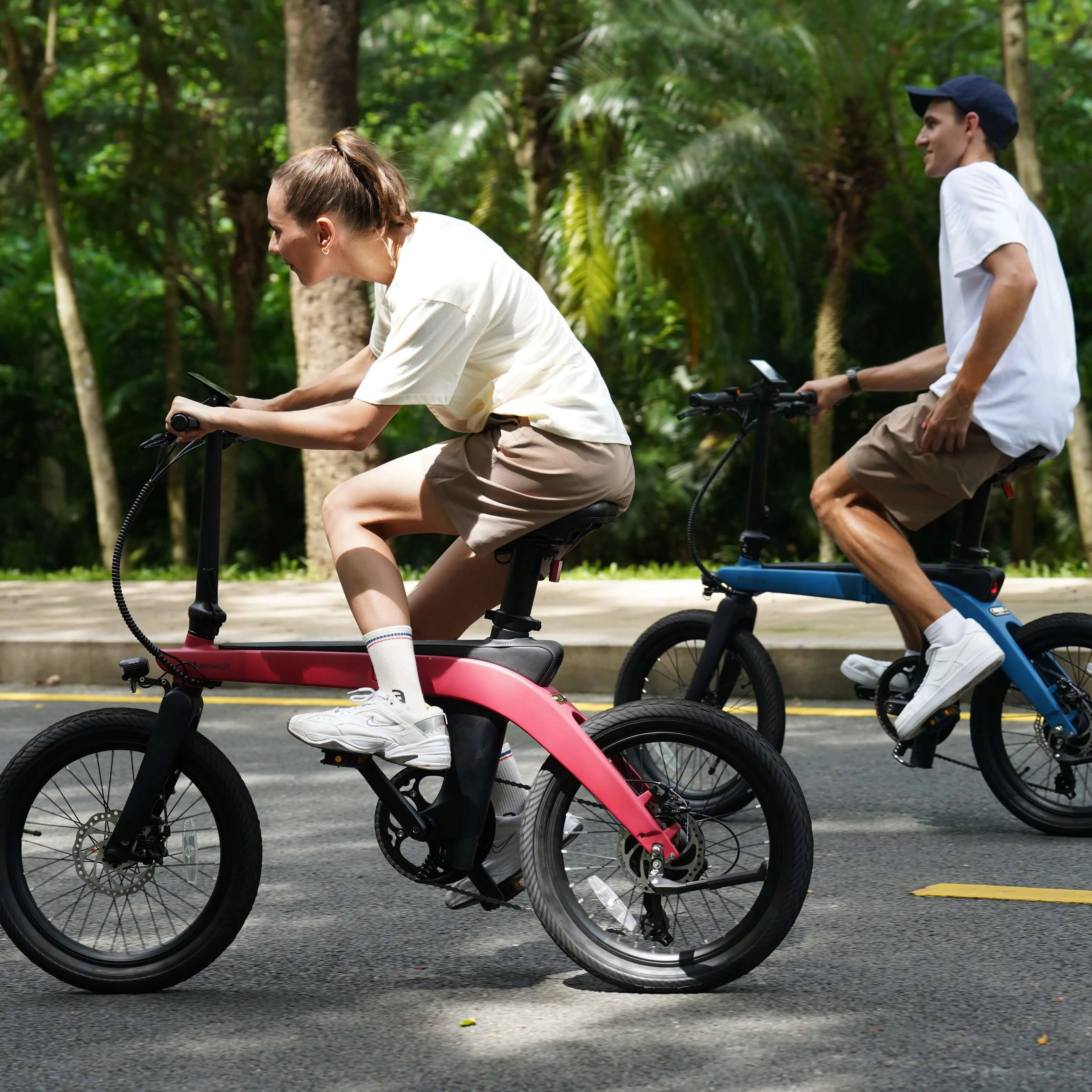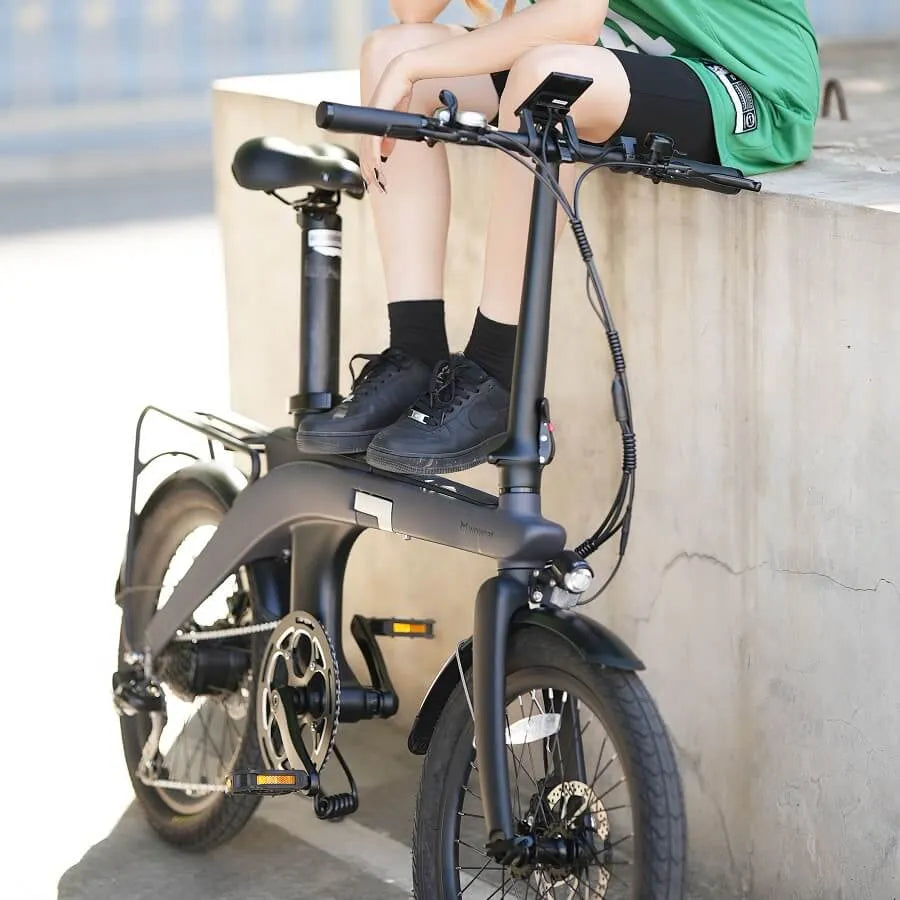In the evolving landscape of urban commuting, two wheeled wonders have risen to prominence, each offering a unique blend of convenience and efficiency. Enter the electric bike (e-bike) and the moped, two distinct modes of two-wheeled transport that share the roads with traditional bicycles and motorized vehicles. As the demand for alternative and eco-friendly transportation surges, understanding the disparities between these vehicles becomes paramount. Join us as we unravel the complexities of the E-Bike vs Moped debate. Whether you're a city dweller seeking a swift commute or an eco-conscious adventurer, the decision between an e-bike and a moped could very well define your journey on the open road.
What is an Electric Bike?
An electric bike (e-bike) is a bicycle equipped with an integrated electric motor and battery, designed to assist the rider's pedaling efforts. The electric motor provides varying levels of assistance, making cycling easier and more accessible. E-bikes come in various styles, from commuter bikes to mountain bikes, and are equipped with features such as rechargeable batteries, pedal-assist systems, and onboard displays. They offer a versatile and eco-friendly mode of transportation, allowing riders to cover longer distances, conquer challenging terrains, and enjoy a more comfortable cycling experience.

Pros&Cons of Electric Bikes
Pros of Electric Bikes (E-Bikes):
Assisted Riding: E-bikes provide motorized assistance, making cycling easier, especially for uphill climbs and against strong winds.
Extended Range: With the help of the electric motor, riders can cover longer distances without feeling fatigued, making e-bikes suitable for commuting and recreational rides.
Speed and Efficiency: E-bikes allow riders to maintain higher speeds with less effort, reducing travel time and making commuting more efficient.
Eco-Friendly: E-bikes contribute to sustainable transportation by reducing reliance on motor vehicles, leading to lower carbon emissions and decreased traffic congestion.
Flexibility for Fitness: Riders can choose the level of motor assistance, accommodating different fitness levels and encouraging physical activity.
Reduced Effort: E-bikes make cycling more accessible, allowing riders to travel longer distances or tackle challenging terrain with less physical effort.
Adaptability to Terrain: E-bikes are versatile and suitable for various terrains, making them practical for both urban commuting and off-road adventures.
Cons of Electric Bikes:
Initial Cost: E-bikes can be more expensive than traditional bikes due to the added cost of the electric motor, battery, and associated components.
Weight: E-bikes are generally heavier than traditional bikes, making them less maneuverable and potentially more challenging to transport.
Maintenance Complexity: E-bikes have more components, including the electric motor and battery, which may require specialized maintenance. Repairs or replacements of these components can be more expensive compared to traditional bikes.
Limited Range on a Single Charge: Despite advancements in battery technology, e-bikes still have a limited range on a single charge, requiring riders to plan their journeys accordingly.
Dependency on Charging Infrastructure: E-bike users need access to charging infrastructure, which may be limited in certain areas, potentially affecting long-distance rides.
Regulatory Variability: Regulations governing e-bikes vary widely, and staying informed about local laws is crucial. Some places have restrictions on motor power, speed, or where e-bikes can be ridden.
Perceived Complexity: Some riders may find the additional features and controls on e-bikes intimidating or overly complex, especially if they are accustomed to the simplicity of traditional bikes.

Things to Consider Before Buying an Electric Bike
Purchasing an electric bike (e-bike) involves considering various factors to ensure you choose the right model that aligns with your needs and preferences. Here are key things to consider before buying an electric bike:
Intended Use:
Define the primary purpose of the e-bike. Will it be used for commuting, off-road adventures, leisurely rides, or a combination of these? Different e-bike models are designed for specific purposes.
Type of E-Bike:
There are various types of e-bikes, including commuter bikes, mountain bikes, folding bikes, and cargo bikes. Choose a type that suits your lifestyle and intended use.
Motor Type and Power:
Decide between a hub motor (located in the wheel hub) or a mid-drive motor (located near the bike's bottom bracket). Consider the motor's power, measured in watts (W), and how it aligns with your desired level of assistance.
Battery Capacity and Range:
Check the e-bike's battery capacity, measured in watt-hours (Wh). Higher capacity batteries generally provide longer ranges. Consider the distance you'll be traveling on a single charge and choose a battery that meets your needs.
Charging Time:
Look into the charging time required for the e-bike's battery. Charging times can vary, and some models offer fast-charging capabilities.
Pedal Assist System (PAS):
Understand the pedal assist system and the levels of assistance offered. Some e-bikes come with multiple PAS levels, allowing you to adjust the amount of motor assistance based on your preferences.
Throttle Option:
Determine if you want an e-bike with a throttle, which allows you to control the motor directly without pedaling. Throttles are common in certain types of e-bikes, especially those designed for off-road use.
Weight and Frame Design:
Consider the weight of the e-bike, especially if you need to lift or transport it. Additionally, evaluate the frame design for comfort and suitability to your riding style.
Tire Type and Size:
The type and size of tires can impact the e-bike's performance on different terrains. Choose tires that match your intended use, whether it's for city commuting, off-road trails, or a mix of both.
Braking System:
Evaluate the braking system, as stopping power is crucial for safety. Disc brakes are common on e-bikes and provide reliable stopping performance.
Gearing System:
Consider the gearing system, especially if you plan to tackle hilly terrain. E-bikes may have traditional derailleurs or internal hub gears.
Comfort and Fit:
Test ride the e-bike to assess comfort and fit. Consider factors such as saddle comfort, handlebar design, and overall ergonomics.
Regulations and Local Laws:
Be aware of e-bike regulations and local laws in your area. Regulations may specify maximum motor power, speed limits, and where e-bikes are allowed to operate.
Brand Reputation and Reviews:
Research the reputation of the e-bike brand and read reviews from other users. This can provide insights into the bike's reliability and performance.
Warranty and After-Sales Service:
Check the warranty offered by the manufacturer and the availability of after-sales service. A reputable brand with good customer support can be valuable in case of issues.
By thoroughly considering these factors, you can make an informed decision and select an electric bike that aligns with your preferences and intended use. Test riding different models and consulting with e-bike experts can further aid in the decision-making process.
What is a Moped?
A moped is a small, lightweight motorized vehicle designed for efficient and convenient short-distance transportation. The term "moped" is a portmanteau of "motor" and "pedal," reflecting its characteristic features of having both a small motor engine and pedals for human propulsion. Here's a brief overview of mopeds:
Engine Size:
Mopeds are typically equipped with small, low-powered engines, often ranging from 50cc to 125cc. This engine size distinguishes them from more powerful motorcycles.
Pedal Assistance:
Mopeds come with pedals that allow the rider to manually propel the vehicle. While the engine provides primary propulsion, pedals can be used to assist in starting from a stop or for additional power, especially on inclines.
Design and Construction:
Mopeds are designed for simplicity and ease of use. They typically feature a step-through frame, allowing riders to easily mount and dismount, and are equipped with a comfortable riding position.
Speed and Classifications:
Mopeds are generally classified based on their top speed. Class I mopeds have a maximum speed of around 20 mph, while Class II mopeds can reach speeds up to 30 mph. These classifications may vary by region.
License and Registration:
Depending on local regulations, mopeds may require a specific license or registration. In some areas, a regular driver's license or even no license may be sufficient for operating a moped.
Use and Commuting:
Mopeds are commonly used for short-distance commuting and urban transportation. Their fuel efficiency and compact size make them suitable for navigating through traffic and reaching destinations quickly.
Variations:
There are variations of mopeds, including electric mopeds (e-mopeds) that are powered by electric motors. These electric variants are gaining popularity for their environmental sustainability.
Storage and Parking:
Mopeds are easy to park and store due to their compact size. They are often preferred in urban areas where parking space is limited.
Helmet Requirements:
Helmet requirements for moped riders vary by jurisdiction. In some places, helmet use may be mandatory, while in others, it might depend on factors such as the rider's age or the moped's top speed.
Economic and Environmental Considerations:
Mopeds are often chosen for their fuel efficiency and low operating costs. They produce fewer emissions compared to some other motorized vehicles, aligning with environmental considerations.
While mopeds share similarities with scooters, the distinction lies in the presence of pedals on mopeds, emphasizing the option for human-powered assistance. Mopeds provide a practical and economical transportation solution for short-distance travel in various urban and suburban settings.
Pros&Cons of Moped
Pros of Mopeds:
Fuel Efficiency:
Mopeds are highly fuel-efficient, making them a cost-effective transportation option. They can travel long distances on a relatively small amount of fuel.
Low Operating Costs:
Mopeds generally have lower operating costs compared to cars or motorcycles. They require less maintenance, and fuel expenses are minimal.
Compact Size:
Mopeds are compact and easy to maneuver, making them well-suited for navigating through congested urban traffic. Finding parking spaces is also more convenient.
Low Emissions:
Mopeds produce fewer emissions than many other motorized vehicles, contributing to environmental sustainability and reduced air pollution.
Ease of Use:
Mopeds are user-friendly, especially for beginners. The step-through frame and simple controls make them accessible to a wide range of riders.
Affordability:
Mopeds are often more affordable than cars or motorcycles, both in terms of purchase price and ongoing expenses.
No Traffic Jams:
Mopeds can often navigate through traffic jams more easily than larger vehicles, allowing riders to reach their destinations more quickly.
Pedal Assistance:
The presence of pedals allows for human-powered assistance, providing an option for exercise and manual control.
Cons of Mopeds:
Limited Speed:
Mopeds are designed for lower speeds, which may limit their use on highways or roads with higher speed limits.
Weather Exposure:
Riders are exposed to the weather elements, which can be a disadvantage during adverse weather conditions such as rain or extreme temperatures.
Limited Cargo Capacity:
Mopeds typically have limited cargo capacity, restricting their ability to carry large or bulky items.
Safety Concerns:
Mopeds may be less visible to other road users, potentially raising safety concerns, especially in heavy traffic.
Hill Climbing:
While mopeds have engines to assist in propulsion, they may struggle on steep inclines, requiring more effort from the rider.
License Requirements:
Depending on local regulations, a specific license or registration may be required to operate a moped, adding a level of complexity compared to bicycles.
Limited Range:
Mopeds have a limited range on a single tank of fuel, requiring frequent refueling for longer journeys.
Helmet Requirements:
In many places, helmet use is required when riding a moped, which may be considered an inconvenience by some riders.
Ultimately, the suitability of a moped depends on individual preferences, local regulations, and the intended use of the vehicle. While they offer numerous advantages, potential buyers should weigh these pros and cons to make an informed decision based on their specific needs.
Things to Consider Before Buying a Moped
When considering buying a moped, there are several factors to take into account to ensure that the chosen moped meets your needs and preferences. Here are key things to consider before making a purchase:
Purpose and Intended Use:
Determine the primary purpose of the moped. Will it be used for commuting, leisurely rides, or both? Understanding your intended use will guide your selection.
Engine Size:
Consider the engine size of the moped. Different engine sizes may have varying top speeds and power levels. Choose an engine size that aligns with your intended use and local regulations.
Licensing Requirements:
Check the licensing requirements in your area. Some regions may require a specific license or registration to operate a moped, while others may only require a regular driver's license.
Speed Limits:
Be aware of the speed limits for mopeds in your area. Some places have specific speed restrictions for mopeds on certain roads.
Fuel Efficiency:
Assess the fuel efficiency of the moped. Mopeds are known for their excellent fuel economy, but it's still important to consider how far you can travel on a single tank of fuel.
Brand Reputation:
Research the reputation of the moped brand. Look for reviews and feedback from other users to ensure the reliability and durability of the chosen brand.
Maintenance Requirements:
Consider the maintenance requirements of the moped. Assess factors such as ease of maintenance, availability of spare parts, and the cost of repairs.
Comfort and Ergonomics:
Test ride the moped to assess its comfort and ergonomics. Check factors such as seat comfort, handlebar positioning, and overall riding posture.
Storage and Parking:
Evaluate the storage options on the moped. Some models may have under-seat storage or additional compartments, which can be valuable for carrying small items. Additionally, consider the moped's size for parking convenience.
Safety Features:
Check for safety features such as reliable brakes, proper lighting, and reflective elements. These features are crucial for visibility and overall safety, especially during nighttime rides.
Weather Protection:
Consider how well the moped protects you from the weather. Some models may have additional features, such as windshields or weather-resistant materials, to enhance rider comfort.
Resale Value:
Investigate the resale value of the moped. While this may not be an immediate concern, it's good to know how well the moped retains its value over time.
Test Ride:
Whenever possible, take the moped for a test ride. This hands-on experience allows you to evaluate its performance, handling, and overall feel.
Warranty:
Check the warranty offered by the manufacturer. A comprehensive warranty can provide peace of mind and protection against potential issues.
Local Regulations:
Familiarize yourself with local regulations regarding mopeds. This includes where you can ride, helmet requirements, and any specific rules applicable to mopeds in your area.
By carefully considering these factors, you can make an informed decision when choosing a moped that aligns with your preferences, lifestyle, and intended use.
What is the Difference between an e-bike and a moped?
The main differences between an electric bike (e-bike) and a moped lie in their design, power source, speed capabilities, and licensing requirements. Here's a breakdown of the distinctions between the two:
Power Source:
E-Bike: E-bikes are primarily powered by an electric motor and a rechargeable battery. They are designed to assist the rider's pedaling efforts, providing an extra boost of power.
Moped: Mopeds, on the other hand, have an internal combustion engine, typically fueled by gasoline. While mopeds have pedals, the engine is the primary source of propulsion.
Pedaling Assistance:
E-Bike: E-bikes are equipped with pedals, and the electric motor provides assistance to the rider's pedaling efforts. The degree of assistance can often be adjusted through different power levels.
Moped: Mopeds also have pedals, but the engine is capable of propelling the vehicle independently. The pedals on a moped are often used for starting from a stop or providing additional power, rather than being the primary source of propulsion.
Maximum Speed:
E-Bike: E-bikes are designed for lower speeds, generally ranging from 20 to 28 mph (32 to 45 km/h), depending on local regulations and the specific model.
Moped: Mopeds have higher speed capabilities, often reaching speeds of 30 mph (48 km/h) or more. The top speed can vary based on the engine size and local regulations.
Licensing Requirements:
E-Bike: In many places, e-bikes do not require a specific license to operate. Riders may only need to adhere to age restrictions and helmet laws.
Moped: Mopeds often require a specific license or registration, similar to that of a motorcycle or scooter. Licensing requirements can vary by jurisdiction.
Engine Type:
E-Bike: E-bikes use electric motors, which are quiet, produce no emissions during operation, and are generally considered environmentally friendly.
Moped: Mopeds have internal combustion engines, typically fueled by gasoline. They emit exhaust and noise during operation.
Environmental Impact:
E-Bike: E-bikes are considered environmentally friendly, producing no emissions during use. They contribute to sustainable transportation and are often favored for their eco-conscious design.
Moped: Mopeds, while more fuel-efficient than many cars, produce emissions due to the combustion of gasoline.
Weight and Design:
E-Bike: E-bikes are generally lighter and have a design similar to traditional bicycles, with the electric components integrated into the frame.
Moped: Mopeds are heavier, with a design that often includes a step-through frame and larger wheels compared to e-bikes.
Cost:
E-Bike: E-bikes can vary in price but are often more affordable than mopeds. Operating costs are generally lower due to the use of electricity.
Moped: Mopeds may have a higher upfront cost and higher operating costs due to fuel expenses.
Understanding these differences can help individuals choose the type of two-wheeled transportation that best suits their needs, preferences, and local regulations.











